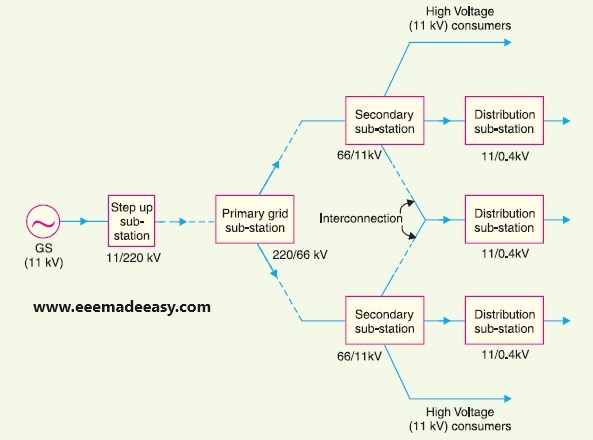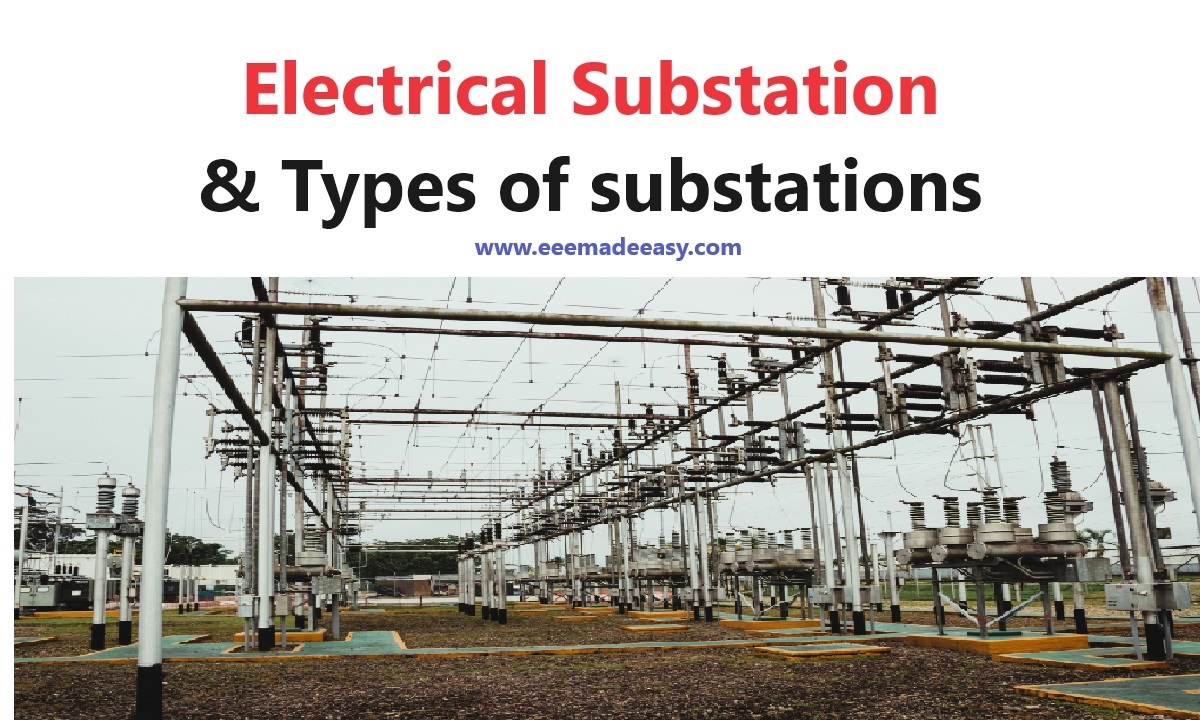Electrical Substation: The assembly of apparatus used to change some characteristics such as voltage, a.c. to d.c., frequency, p.f. of electric supply is called a sub-station.
Electrical substation
A substation is a part of an electrical generation, transmission, and distribution system. Substations transform voltage from high to low, or the reverse, or perform any of several other important functions.
Sub-stations are important part of power system. The continuity of supply depends to a considerable extent upon the successful operation of sub-stations.
Download & Install EEE Made Easy App
It is, therefore, essential to exercise utmost care while designing and building a sub-station.
The following are the important points which must be kept in view while laying out a sub-station
(i) It should be located at a proper site. As far as possible, it should be located at the centre of
gravity of load.
(ii) It should provide safe and reliable arrangement. For safety, consideration must be given to
the maintenance of regulation clearances, facilities for carrying out repairs and maintenance,
abnormal occurrences such as possibility of explosion or fire etc.
For reliability, consideration must be given for good design and construction, the provision of suitable protective gear etc.
(iii) It should be easily operated and maintained.
(iv) It should involve minimum capital cost.
Types of Substation
The main Classification of Substations are given below;
There are several ways of classifying substations. However, the two most important ways of classifying them are according to
- service requirement and
- constructional features.
According to service requirement
A sub-station may be called upon to change voltage level or improve power factor or convert a.c. power into d.c. power etc.
According to the service requirement, sub-stations may be classified into :
(i) Transformer sub-stations
Those sub-stations which change the voltage level of electric
supply are called transformer sub-stations.
These sub-stations receive power at some voltage and deliver it at some other voltage. Obviously, transformer will be the main component in such substations.
Most of the sub-stations in the power system are of this type.
(ii) Switching substations
These sub-stations do not change the voltage level i.e. incoming and outgoing lines have the same voltage.
However, they simply perform the switching operations of power lines.
(iii) Power factor correction substations
Those sub-stations which improve the power factor of the system are called power factor correction sub-stations.
Such sub-stations are generally located at the receiving end of transmission lines.
These sub-stations generally use synchronous condensers as the power factor improvement equipment.
(iv) Frequency changer substations
Those sub-stations which change the supply frequency are known as frequency changer sub-stations.
Such a frequency change may be required for industrial utilisation.
(v) Converting substations
Those sub-stations which change a.c. power into d.c. power are called converting sub-stations.
These sub-stations receive a.c. power and convert it into d.c. power with suitable apparatus (e.g. ignitron) to supply for such purposes as traction, electroplating, electric welding etc.
(vi) Industrial substations
Those sub-stations which supply power to individual industrial concerns are known as industrial sub-stations.
According to constructional features
A sub-station has many components (e.g. circuit breakers, switches, fuses, instruments etc.) which must be housed properly to ensure continuous and
reliable service.
According to constructional features, the sub-stations are classified as :
- Indoor sub-station
- Outdoor sub-station
- Underground sub-station
- Pole-mounted sub-station
(i) Indoor substations
For voltages upto 11 kV, the equipment of the sub-station is installed indoor because of economic considerations.
However, when the atmosphere is contaminated with impurities, these sub-stations can be erected for voltages upto 66 kV.
(ii) Outdoor substations
For voltages beyond 66 kV, equipment is invariably installed outdoor.
It is because for such voltages, the clearances between conductors and the space required for
switches, circuit breakers and other equipment becomes so great that it is not economical to install the equipment indoor.
(iii) Underground substations
In thickly populated areas, the space available for equipment and building is limited and the cost of land is high. Under such situations, the sub-station is created underground.
(iv) Pole-mounted substations
This is an outdoor sub-station with equipment installed overhead on H-pole or 4-pole structure.
It is the cheapest form of sub-station for voltages not exceeding 11kV (or 33 kV in some cases).
Electric power is almost distributed in localities through such substations.
Outdoor Substations Vs Indoor Substations
The comparison between outdoor and indoor sub-stations is given below.
| Sl No | Particular | Outdoor Substation | Indoor Substation |
|---|---|---|---|
| 1 | Space required | More | Less |
| 2 | Time required for erection | Less | More |
| 3 | Future extension | Easy | Difficult |
| 4 | Fault location | Easier beacuse the equipment is in full view | Difficult because the quipment is enclosed |
| 5 | Capital cost | Low | High |
| 6 | Operation | Difficult | Easier |
| 7 | Possibility of fault escalation | Less because greater clearances can be provided | More |
From the above comparison, it is clear that each type has its own advantages and disadvantages.
However, comparative economics (i.e. annual cost of operation) is the most powerful factor influencing the choice between indoor and outdoor sub-stations.
The greater cost of indoor sub-station prohibits its use.
But sometimes non-economic factors (e.g. public safety) exert considerable influence in choosing indoor sub-station.
In general, most of the sub-stations are of outdoor type and the indoor sub-stations are erected only where outdoor construction is impracticable or prohibited by the local
laws.
Transformer Sub-Stations
The majority of the sub-stations in the power system are concerned with the changing of voltage level of electric supply.
These are known as transformer substations because transformer is the main component employed to change the voltage level.
Depending upon the purpose served, transformer sub-stations may be classified into :
- Step-up sub-station
- Primary grid sub-station
- Secondary sub-station
- Distribution sub-station
Fig. shows the block diagram of a typical electric supply system indicating the position of above types of sub-stations.

It may be noted that it is not necessary that all electric supply schemes include all the stages shown in the figure.
For example, in a certain supply scheme there may not be secondary sub-stations and in another case, the scheme may be so small that there are only distribution sub-stations.
(i) Step-up sub-station
The generation voltage (11 kV in this case) is stepped up to high voltage (220 kV) to affect economy in transmission of electric power.
The sub-stations which accomplish this job are called step-up sub-stations.
These are generally located in the power houses and are of outdoor type.
(ii) Primary grid sub-station
From the step-up sub-station, electric power at 220 kV is transmitted by 3-phase, 3-wire overhead system to the outskirts of the city.
Here, electric power is received by the primary grid sub-station which reduces the voltage level to 66 kV for secondary transmission.
The primary grid sub-station is generally of outdoor type.
(iii) Secondary sub-station
From the primary grid sub-station, electric power is transmitted at 66 kV by 3-phase, 3-wire system to various secondary sub-stations located at the strategic points in the city.
At a secondary sub-station, the voltage is further stepped down to 11 kV. The 11 kV lines
run along the important road sides of the city.
It may be noted that big consumers (having demand more than 50 kW) are generally supplied power at 11 kV for further handling with their own sub stations.
The secondary sub-stations are also generally of outdoor type.
(iv) Distribution sub-station
The electric power from 11 kV lines is delivered to distribution sub-stations.
These sub-stations are located near the consumers localities and step down the voltage
to 400 V, 3-phase, 4-wire for supplying to the consumers.
The voltage between any two phases is 400V and between any phase and neutral it is 230 V.
The single phase residential lighting load is connected between any one phase and neutral whereas 3-phase, 400V motor load is connected across 3-phase lines directly.
It may be worthwhile to mention here that majority of the distribution substations are of pole-mounted type.
- [MCQ Set 1]Electrical Power Generation, Transmission and Distribution MCQ Questions|EEE Made Easy
- [MCQ Set 2]Electrical Power Generation, Transmission and Distribution MCQ Questions|EEE Made Easy
Latest Posts
- Industries Extension Officer Syllabus Kerala PSC|IEO 2024 Syllabus
- [PDF]Trade Instructor Gr.II Electroplating Syllabus Kerala PSC|92/2023 syllabus
- [PDF] Syllabus Assistant Engineer Electrical Harbour Engineering Kerala PSC
- Industries Extension Officer Kerala PSC Notification|IEO 2024
- Electricity Act 2003 Section 135
- Synchronous Motor Advantages, Disadvantages & Applications
- [Latest]Assistant Director industries and commerce Kerala PSC syllabus|630/2023 syllabus







